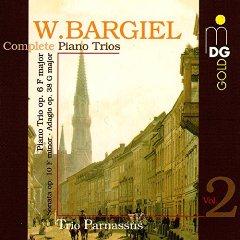Woldemar Bargiel - Piano Trios (Vol.2) [1998]
Woldemar Bargiel - Piano Trios (Vol.2) [1998]

Piano Trio No. 1 in F major, Op. 6 01. Adagio - Allegro energico [0:13:28.22] 02. Andante sostenuto [0:07:06.15] 03. Scherzo - Presto - Commodo - Tempo Imo [0:07:22.60] 04. Allegro con fuoco [0:11:22.40] 05. Adagio for cello & orchestra in G major, Op. 38 [0:08:19.47] Sonata for violin & piano in F minor, Op. 10 06. Allegro [0:14:02.33] 07. Andante sostenuto [0:07:24.73] 08. Allegro molto [0:10:15.25] Trio Parnassus: Wolfgang Schröder - Violin (tracks: 1-4, 6-8) Michael Groß - Cello (tracks: 1-5) Chia Chou - Piano
Woldemar Bargiel (1828-1897, Germany) was a contemporary of Brahms, and shared a connection of more than just chronology, in that he was the half-brother of Clara Schumann. He too wrote three piano trios, at which point the similarities cease. Trio Parnassus, whose name will appear many times throughout this survey linked to little known composers, have made the only recordings of the three. They are on two separate CDs, but alas the one with two of the three is no longer available on CD. It can be purchased from a number of download sites, but without a booklet, one of my pet peeves, and rather important for such a little known composer. What I have heard is unsurprisingly Brahmsian, and of sufficient quality to tempt me to overcome my “no booklet” aversion. ---musicweb-international.com
Woldemar Bargiel (1828-97) was the half-brother of Clara Wieck Schumann; Clara's mother, Mariane Tromlitz, divorced Friedrich Wieck and married Adolph Bargiel. Nine years Clara's junior, Woldemar adored his half-sister and was on intimate terms with her and her husband, Robert Schumann. On the recommendation of Schumann and Mendelssohn he undertook studies at the Leipzig Conservatory with such well-know figures as Ignaz Moscheles, Niels Gade, and Julius Rietz. In 1859 he accepted an invitation from Ferdinand Hiller to teach at the Cologne Conservatory, followed by a similar stint at the leading conservatory in Rotterdam from 1865 to 1874. He then accepted an invitation from Joseph Joachim to teach at the Berlin Academy of Music, where he remained until his death, which occurred only a few weeks before that of his friend and colleague Johannes Brahms, with whom he collaborated on editing complete editions of the music of Schumann and Chopin. Because he devoted himself primarily to pedagogy, Bargiel's compositional output was fairly small and focused primarily on chamber music. All of his music displays solid craftsmanship and remains firmly in the musical lineage of Mendelssohn and the Leipzig school of composition. This disc, Volume 2 devoted to the chamber works, features what may be Bargiel's finest work, the Op. 10 Violin Sonata. A work of the Sturm und Drang style of early Romanticism, it is a passionate outpouring of dramatic emotion, with a riveting opening theme in the first movement. The other two works are of a gentler, more lyrical character, the op. 6 Trio was the work that first brought Bargiel's credentials as a composer to a wider public, while the one-movement Adagio for Cello and Orchestra (the latter part reduced to piano by the composer) is a distant kin to Max Bruch's famous Kol Nidrei.
The Trio Parnassus is a capable ensemble, though not quite of the first rank; for example, violinist Isabelle Faust is a superior interpreter of the Violin Sonata in her recent recording. But given that these are likely to be the only recordings of Bargiel's works for some time to come, the performers are only to be praised for making this fine music available to us all. ---James A. Altena, amazon.com
download (mp3 @320 kbs):








